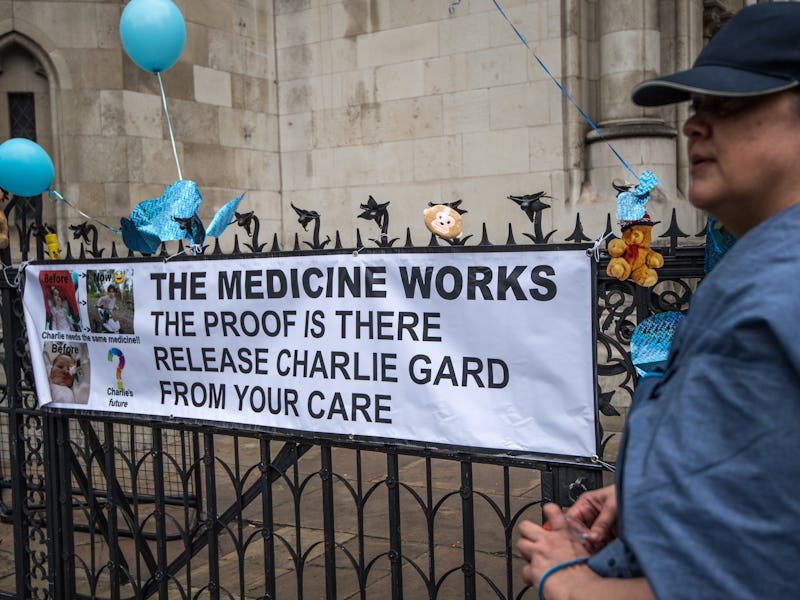Could Nucleoside Bypass Therapy Have Helped Charlie Gard?
It is so experimental it hasn’t received a clinical trial yet.

On Friday, Charlie Gard, a nearly year-old infant whose rare and debilitating genetic disease thrust him into a media spotlight as his parents fought to save his life, died in hospice care.
The British infant was born with a rare condition known as mitochondrial DNA depletion syndrome. The condition causes brain damage and loss of muscle function; Charlie could not see, hear, cry, or swallow, and he needed a ventilator to breathe.
Over the year of Charlie’s life an emotional battle had played out in the British court system as Charlie’s parents, Connie Yates and Chris Gard, raised over $1.7 million and tried to have the infant moved to an American hospital for experimental treatment. But doctors treating Charlie at Great Ormond Street Hospital in central London had objected, saying the treatment wouldn’t help Charlie’s debilitating condition and might cause the child to suffer more.
Supporters of Chris Gard and Connie Yates, the parents of terminally ill toddler Charlie Gard, hold a banner outside The Royal Courts of Justice on July 13, 2017 in London.
The experimental treatment Charlie’s parents campaigned for was called nucleoside bypass therapy. The treatment is being developed by Dr. Michio Hirano, a neurologist at Columbia University. The treatment is so experimental it hasn’t received a clinical trial yet, and it hadn’t yet been tried on anyone with Charlie’s specific disease.
According to Scientific American, the treatment could in theory have counteracted a mutation in Charlie’s genes that inhibited mitochondria from replacing damaged DNA.
The therapy supplies the building blocks of DNA. Charlie has a mutation in a gene called RRM2B, which codes for the production of an enzyme that helps produce the four “letters” (nucleotides) that constitute DNA in mitochondria.
A mutated gene produces a dysfunctional enzyme; without a functional enzyme, mitochondria can’t replace DNA that’s damaged or deteriorated. Eventually, mitochondria—and the cells they power—stop working, with devastating effects especially on cells of the muscles and brain. Nucleosides are precursors to nucleotides; they’re turned into the latter in the body, providing the missing components of DNA.
Hirano claims the therapy has been used on 18 patients so far. However, those patients had a mutation in a different gene than Charlie — the TK2 gene, whereas Charlie’s disease concerned a gene called RRM2B — although both genes produce mitochondrial DNA depletion. Although proper clinical trials in the U.S. concerning nucleoside bypass therapy are being pursued, they are being explored for TK2, not RRM2B.
Six months after being invited by Charlie’s parents, Hirano traveled to London in July to examine Charlie. It was determined, however, that Charlie had suffered muscular atrophy and that the treatment could not counteract the damage of his disease. It was at this point that Charlie’s parents decided to give up a legal fight to have him taken to the U.S. for treatment.
Some ethicists have claimed Hirano gave the family false hopes by claiming he might be able to help the child before actually examining him. On July 24, Great Ormond Street hospital released a statement echoing those sentiments.
“On 13 July he stated that not only had he not visited the hospital to examine Charlie but in addition, he had not read Charlie’s contemporaneous medical records or viewed Charlie’s brain imaging or read all of the second opinions about Charlie’s condition (obtained from experts, all of whom had taken the opportunity to examine him and consider his records) or even read the judge’s decision made on 11 April.”
According to The Guardian, Julian Savulescu, the Uehiro chair in practical ethics at the University of Oxford countered that the hospital’s
He said that although the hospital had said Charlie should not be treated because he had irreversible brain damage, the MRI scan in January showed normal brain structure, even though the EEG tests showed very abnormal brain activity. This led Charlie’s parents to believe treatment was possible at that time and to fight the court judgment ,which appeared to be based on brain damage. The hospital should be allowed to release their evidence about his condition, Savulescu said.